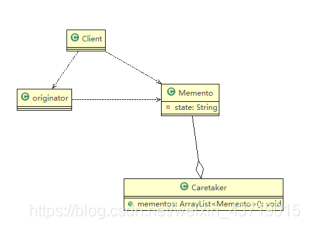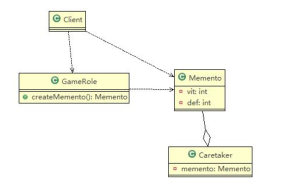游戏角色状态恢复问题
游戏角色有攻击力和防御力,在大战Boss前保存自身的状态(攻击力和防御力),当大战Boss后攻击力和防御力下降,从备忘录对象恢复到大战前的状态

传统的方式的问题分析
- 一个对象,就对应一个保存对象状态的对象, 这样当我们游戏的对象很多时,不利于管理,开销也很大.
- 传统的方式是简单地做备份,new出另外一个对象出来,再把需要备份的数据放到这个新对象,但这就暴露了对象内部的细节
- 解决方案: => 备忘录模式
备忘录模式
基本介绍
- 备忘录模式(Memento Pattern)在不破坏封装性的前提下,捕获一个对象的内部状态,并在该对象之外保存这个状态。这样以后就可将该对象恢复到原先保存的状态
- 可以这里理解备忘录模式:现实生活中的备忘录是用来记录某些要去做的事情,或者是记录已经达成的共同意见的事情,以防忘记了。而在软件层面,备忘录模式有着相同的含义,备忘录对象主要用来记录一个对象的某种状态,或者某些数据,当要做回退时,可以从备忘录对象里获取原来的数据进行恢复操作
- 备忘录模式属于行为型模式
原理类图
对原理 类图 的说明- - 即( 备忘录模 式的角色及职 责)
- originator : 对象( ( 需要保存状态的对象) )
- Memento : : 备忘 录对象, , 负责保存好 记 录,即 Originator 内部状态
- Caretaker: 守护者对象, , 负责保存多个备忘录对象, 使用集合管理,提高效率
- 说明:如果希望保存多个 originator 对象的不同时间的状态,也可以,只需要 HashMap <String, 集合 >
应用实例要求
游戏角色有攻击力和防御力,在大战Boss前保存自身的状态(攻击力和防御力),当大战Boss后攻击力和防御力下降,从备忘录对象恢复到大战前的状态
//需要备忘的对象,即需要保存状态属性的对象
public class GameRole {
private int vit;
private int def;
//创建Memento ,即根据当前的状态得到Memento
public Memento createMemento() {
return new Memento(vit, def);
}
//从备忘录对象,恢复GameRole的状态
public void recoverGameRoleFromMemento(Memento memento) {
this.vit = memento.getVit();
this.def = memento.getDef();
}
//显示当前游戏角色的状态
public void display() {
System.out.println("游戏角色当前的攻击力:" + this.vit + " 防御力: " + this.def);
}
public int getVit() {
return vit;
}
public void setVit(int vit) {
this.vit = vit;
}
public int getDef() {
return def;
}
public void setDef(int def) {
this.def = def;
}
}
public class Memento {//纪念品
//攻击力
private int vit;
//防御力
private int def;
public Memento(int vit, int def) {
super();
this.vit = vit;
this.def = def;
}
public int getVit() {
return vit;
}
public void setVit(int vit) {
this.vit = vit;
}
public int getDef() {
return def;
}
public void setDef(int def) {
this.def = def;
}
}
//守护者对象, 保存游戏角色的状态
public class Caretaker {
//如果只保存一次状态
private Memento memento;
//对GameRole 保存多次状态
//private ArrayList<Memento> mementos;
//对多个游戏角色保存多个状态
//private HashMap<String, ArrayList<Memento>> rolesMementos;
public Memento getMemento() {
return memento;
}
public void setMemento(Memento memento) {
this.memento = memento;
}
/////////////////////////////////////
//在List 集合中会有很多的备忘录对象
private List<Memento> mementoList = new ArrayList<Memento>();
public void add(Memento memento) {
mementoList.add(memento);
}
//获取到第index个Originator 的 备忘录对象(即保存状态)
public Memento get(int index) {
return mementoList.get(index);
}
}
//Client
public class Client {
public static void main(String[] args) {
//创建游戏角色
GameRole gameRole = new GameRole();
gameRole.setVit(100);
gameRole.setDef(100);
System.out.println("和boss大战前的状态");
gameRole.display();
//把当前状态保存caretaker
Caretaker caretaker = new Caretaker();
caretaker.setMemento(gameRole.createMemento());
System.out.println("和boss大战~~~");
gameRole.setDef(30);
gameRole.setVit(30);
gameRole.display();
System.out.println("大战后,使用备忘录对象恢复到站前");
gameRole.recoverGameRoleFromMemento(caretaker.getMemento());
System.out.println("恢复后的状态");
gameRole.display();
}
}
类图:
备忘录模式的注意事项和细节
- 给用户提供了一种可以恢复状态的机制,可以使用户能够比较方便地回到某个历史的状态
- 实现了信息的封装,使得用户不需要关心状态的保存细节
- 如果类的成员变量过多,势必会占用比 较大的资源,而且每一次保存都会消耗一定的内存, 这个需要注意
- 适用的应用场景:1.后悔药。 2.打游戏时的存档。 3.Windows 里的 ctri + z。4.IE 中的后退。 5.数据库的事务管理
- 为了节约内存,备忘录模式可以和原型模式配合使用
来源:CSDN
作者:奋斗小亮
链接:https://blog.csdn.net/weixin_43719015/article/details/104641301